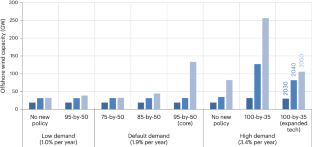2023-10-09 ペンシルベニア州立大学(PennState)
◆地球温暖化の影響を最小限に抑えるためには、温室効果ガスの排出を削減する必要があり、これが行われない場合、特に低所得国が最も影響を受ける。この問題に対処するためには、湿度を考慮に入れた暑さ対策が必要である。
<関連情報>
- https://www.psu.edu/news/health-and-human-development/story/climate-driven-extreme-heat-may-make-parts-earth-too-hot-humans/
- https://www.pnas.org/doi/10.1073/pnas.2305427120
経験的に決定された湿潤熱ストレス耐性の低さの結果として、人体へのリスクが大幅に高まった。 Greatly enhanced risk to humans as a consequence of empirically determined lower moist heat stress tolerance
Daniel J. Vecellio, Qinqin Kong, W. Larry Kenney, and Matthew Huber
Proceedings of the National Academy of Sciences Published:October 9, 2023
DOI:https://doi.org/10.1073/pnas.2305427120

Significance
Increased heat and humidity potentially threaten people and societies. Here, we incorporate our laboratory-measured, physiologically based wet-bulb temperature thresholds across a range of air temperatures and relative humidities, to project future heat stress risk from bias-corrected climate model output. These vulnerability thresholds substantially increase the calculated risk of widespread potentially dangerous, uncompensable humid heat stress. Some of the most populated regions, typically lower-middle income countries in the moist tropics and subtropics, violate this threshold well before 3 °C of warming. Further global warming increases the extent of threshold crossing into drier regions, e.g., in North America and the Middle East. These differentiated patterns imply vastly different heat adaption strategies. Limiting warming to under 2 °C nearly eliminates this risk.
Abstract
As heatwaves become more frequent, intense, and longer-lasting due to climate change, the question of breaching thermal limits becomes pressing. A wet-bulb temperature (Tw) of 35 °C has been proposed as a theoretical upper limit on human abilities to biologically thermoregulate. But, recent—empirical—research using human subjects found a significantly lower maximum Tw at which thermoregulation is possible even with minimal metabolic activity. Projecting future exposure to this empirical critical environmental limit has not been done. Here, using this more accurate threshold and the latest coupled climate model results, we quantify exposure to dangerous, potentially lethal heat for future climates at various global warming levels. We find that humanity is more vulnerable to moist heat stress than previously proposed because of these lower thermal limits. Still, limiting warming to under 2 °C nearly eliminates exposure and risk of widespread uncompensable moist heatwaves as a sharp rise in exposure occurs at 3 °C of warming. Parts of the Middle East and the Indus River Valley experience brief exceedances with only 1.5 °C warming. More widespread, but brief, dangerous heat stress occurs in a +2 °C climate, including in eastern China and sub-Saharan Africa, while the US Midwest emerges as a moist heat stress hotspot in a +3 °C climate. In the future, moist heat extremes will lie outside the bounds of past human experience and beyond current heat mitigation strategies for billions of people. While some physiological adaptation from the thresholds described here is possible, additional behavioral, cultural, and technical adaptation will be required to maintain healthy lifestyles.



